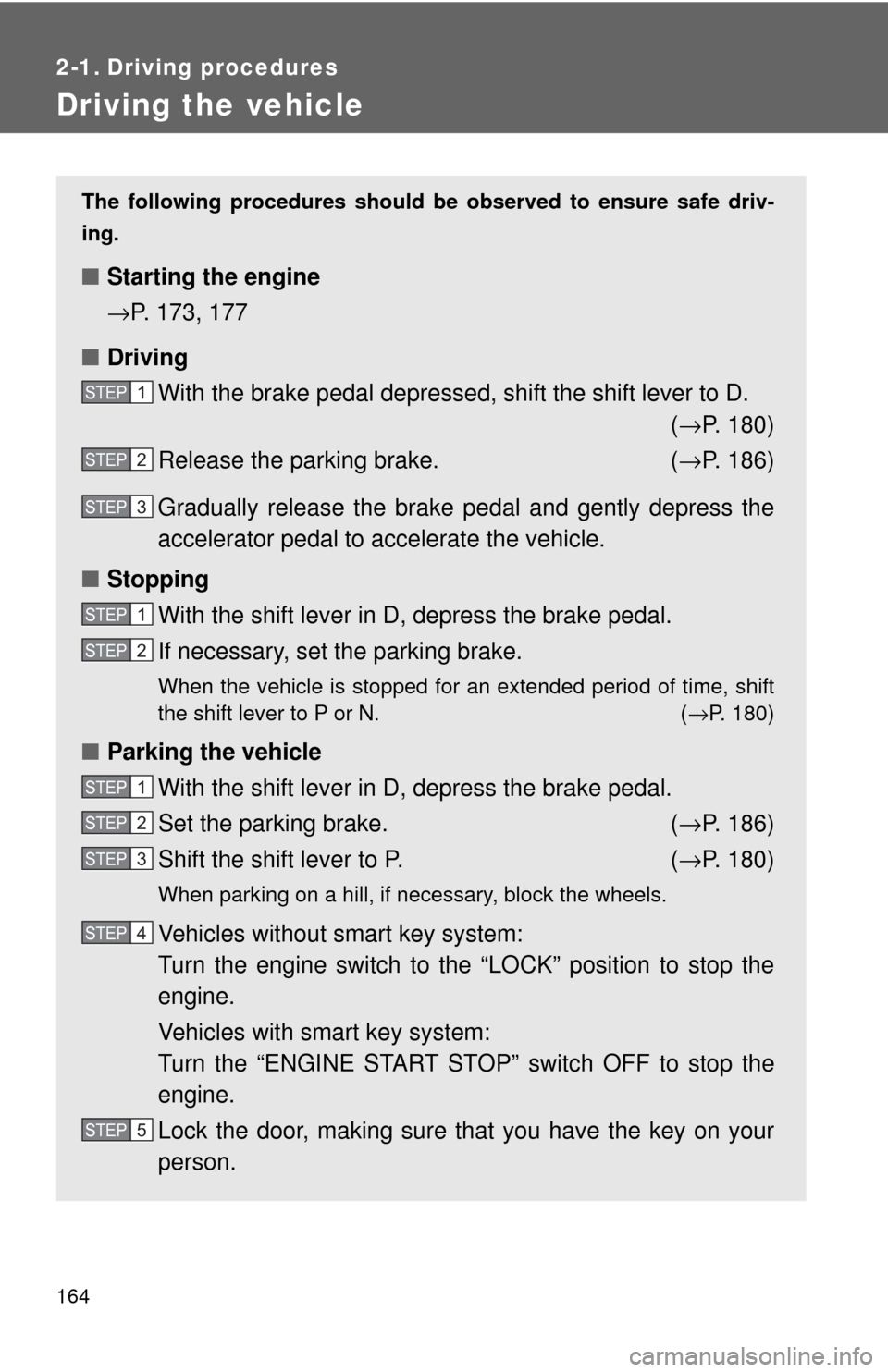2009 TOYOTA HIGHLANDER parking brake
[x] Cancel search: parking brakePage 2 of 608

TABLE OF CONTENTSIndex
2
1-1. Key informationKeys ..................................... 30
1-2. Opening, closing and
locking the doors
Smart key system................. 33
Wireless remote control ....... 54
Side doors ............................ 66
Back door ............................. 71
Glass hatch .......................... 77
1-3. Adjustable components
(seats, mirrors,
steering wheel)
Front seats ........................... 79
Rear seats ............................ 82
Head restraints ..................... 91
Seat belts ............................. 94
Steering wheel ................... 100
Anti-glare inside rear view mirror ................................ 101
Outside rear view mirrors ... 103
1-4. Opening a nd closing the
windo ws and moon roof
Power windows .................. 106
Moon roof ........................... 108
1-5. Refueling Opening the fuel tank cap ................................... 111 1-6. Theft deterrent system
Engine immobilizer system .............................. 115
Alarm .................................. 122
Theft prevention labels (U.S.A.)............................. 125
1-7. Safety information Correct driving posture ....... 126
SRS airbags ....................... 128
Front passenger occupant classification system ......... 140
Child restraint systems ....... 146
Installing child restraints ..... 151
2-1. Driving procedures Driving the vehicle .............. 164
Engine (ignition) switch (vehicles with smart key
system) ............................. 173
Engine (ignition) switch (vehicles without smart
key system) ...................... 177
Automatic Transmission ..... 180
Turn signal lever ................. 185
Parking brake ..................... 186
Horn .................................... 187
2-2. Instrument cluster Gauges and meters ............ 188
Indicators and warning lights ................................. 190
Multi-information display ..... 194
1Before driving
2When driving
Page 16 of 608

16
Rear view monitor system ∗
Multi-information display
∗
Clock
∗
P. 214
P. 194
P. 390
Gauges and me-
ters
P. 188
Tilt and telescopic steering lock release
lever
P. 100
Glove box P. 376
Pictorial indexInstrument panel
Power back door
main switch
∗
P. 71
Enhanced VSC/TRAC off switch P. 219
Tire pressure warning reset switch P. 455
Parking brake pedal P. 186
Hood release lever P. 432
Auxiliary box P. 384
Engine (ignition) switch
(vehicles with smart key system)
P. 173
Fog light switch ∗
Headlight switch
Turn signal lever P. 207
P. 203
P. 185
Windshield wiper and
washer switch
Rear window wiper and
washer switch
P. 208
P. 210
Horn
P. 187
Floor mat P. 399
Page 163 of 608

When driving2
163
2-1. Driving proceduresDriving the vehicle............ 164
Engine (ignition) switch (vehicles with smart
key system).................... 173
Engine (ignition) switch (vehicles without smart
key system).................... 177
Automatic Transmission ................. 180
Turn signal lever .............. 185
Parking brake ................... 186
Horn ................................. 187
2-2. Instrument cluster Gauges and meters ......... 188
Indicators and warning lights .............................. 190
Multi-information display............................ 194 2-3. Operating the lights and
wipers
Headlight switch ............... 203
Fog light switch ................ 207
Windshield wipers and washer ........................... 208
Rear window wiper and washer ........................... 210
2-4. Using other driving systems Cruise control ................... 211
Rear view monitor system (vehicles with multi-
information display) ........ 214
Driving assist systems ..... 218
Hill-start assist control ...... 223
Downhill assist control system
(4WD models
only)......... 225
2-5. Driving information Off-road precautions ........ 228
Cargo and luggage .......... 233
Vehicle load limits ............ 237
Winter driving tips ............ 238
Trailer towing ................... 242
Dinghy towing .................. 252
Page 164 of 608

164
2-1. Driving procedures
Driving the vehicle
The following procedures should be observed to ensure safe driv-
ing.
■ Starting the engine
→P. 173, 177
■ Driving
With the brake pedal depressed, shift the shift lever to D. (→ P. 180)
Release the parking brake. ( →P. 186)
Gradually release the brake pedal and gently depress the
accelerator pedal to accelerate the vehicle.
■ Stopping
With the shift lever in D, depress the brake pedal.
If necessary, set the parking brake.
When the vehicle is stopped for an extended period of time, shift
the shift lever to P or N. ( →P. 180)
■Parking the vehicle
With the shift lever in D, depress the brake pedal.
Set the parking brake. ( →P. 186)
Shift the shift lever to P. ( →P. 180)
When parking on a hill, if necessary, block the wheels.
Vehicles without smart key system:
Turn the engine switch to the “LOCK” position to stop the
engine.
Vehicles with smart key system:
Turn the “ENGINE START STOP ” switch OFF to stop the
engine.
Lock the door, making sure that you have the key on your
person.
STEP1
STEP2
STEP3
STEP1
STEP2
STEP1
STEP2
STEP3
STEP4
STEP5
Page 165 of 608

165
2-1. Driving procedures
2
When driving
Starting on a steep uphill
Firmly set the parking brake and shift the shift lever to D.
Gently depress the accelerator pedal.
Release the parking brake.
■Driving in the rain
●Drive carefully when it is raining, because visibility will be reduced, the
windows may become fogged-up, and the road will be slippery.
● Drive carefully when it starts to rain, because the road surface will be
especially slippery.
● Refrain from high speeds when driving on an expressway in the rain,
because there may be a layer of water between the tires and the road
surface, preventing the steering and brakes from operating properly.
■ Breaking in your new Toyota
To extend the life of the vehicle, the following precautions are recommended
to observe:
●For the first 186 miles (300 km):
Avoid sudden stops.
● For the first 500 miles (800 km):
Do not tow a trailer.
● For the first 621 miles (1000 km):
• Do not drive at extremely high speeds.
• Avoid sudden acceleration.
• Do not drive continuously in the low gears.
• Do not drive at a constant speed for extended periods.
STEP1
STEP2
STEP3
Page 166 of 608

166 2-1. Driving procedures
■Drum-in-disc type parking brake system
Your vehicle has a drum-in-disc type parking brake system.
This type of brake system needs bedding-down of the brake shoes periodi-
cally or whenever the parking brake shoes and/or drums are replaced.
Have your Toyota dealer perform the bedding-down.
■ Operating your vehicle in a foreign country
Comply with the relevant vehicle registration laws and confirm the availability
of the correct fuel. ( →P. 555)
■ Normal characteristics after turning off the engine
Approximately five hours after the engine is turned off, you may hear sound
coming from under the vehicle for several minutes. This is the sound of a
fuel evaporation leakage check and, it does not indicate a malfunction.
CAUTION
■When starting the vehicle
Always keep your foot on the brake pedal while stopped with the engine run-
ning. This prevents the vehicle from creeping.
■ When driving the vehicle
●Do not drive if you are unfamiliar with the location of the brake and accel-
erator pedals to avoid depressing the wrong pedal.
• Accidentally depressing the accelerator pedal instead of the brake
pedal will result in sudden acceleration that may lead to an accident
that could result in death or serious injury.
• When backing up, you may twist your body around, leading to a diffi- culty in operating the pedals. Make sure to operate the pedals properly.
• Make sure to keep a correct driving posture even when moving the vehicle only slightly, allowing you to depress the brake and accelerator
pedals properly.
• Depress the brake pedal using your right foot. Depressing the brake pedal using your left foot may delay response in an emergency, result-
ing in an accident.
● Do not drive the vehicle over or st op the vehicle near flammable materials.
The exhaust system and exhaust gases can be extremely hot. This may
cause a fire if there is any flammable material nearby.
Page 167 of 608

167
2-1. Driving procedures
2
When driving
CAUTION
●
Do not let the vehicle roll backwards while the shift lever is in a driving
position, or roll forward while the shift lever is in R.
Doing so may cause the engine to stall or lead to poor brake and steering
performance, resulting in an accident or damage to the vehicle.
● If the smell of exhaust is noticed inside the vehicle, open the windows and
check that the back door is closed. Large amounts of exhaust in the vehi-
cle can cause driver drowsiness and an accident, resulting in death or a
serious health hazard. Have the vehicle inspected by your Toyota dealer
immediately.
● Do not under any circumstances shift the shift lever to P, R or N while the
vehicle is moving.
Doing so can cause significant damage to the transmission system and
may result in a loss of vehicle control.
● Do not shift the shift lever to N while the vehicle is moving.
Doing so may cause the engine brake to not operate properly and lead to
an accident.
● Do not turn the engine off while driving.
The power steering and brake booster systems will not operate properly if
the engine is not running.
● Use engine braking (downshift) to maintain a safe speed when driving
down a steep hill.
Using the brakes continuously may cause the brakes to overheat and lose
effectiveness. ( →P. 181)
● When stopped on an inclined surface, use the brake pedal and parking
brake to prevent the vehicle from rolling backward or forward and causing
an accident.
● Do not adjust the position of the steering wheel, the seat, or the inside or
outside rear view mirrors while driving.
Doing so may result in a loss of vehicle control that can cause accidents
that may result in death or serious injury.
● Always check that all passengers' arms, heads or other parts of their bod-
ies are not outside the vehicle, as this may result in death or serious injury.
● Do not drive the vehicle off-road.
This is not a 4WD vehicle designed for real off-road driving. Proceed with
all due caution if it becomes unavoidable to drive off-road.
Page 169 of 608

169
2-1. Driving procedures
2
When driving
CAUTION
■
When the vehicle is parked
●Do not leave glasses, cigarette lighters, spray cans, or soft drink cans in
the vehicle when it is in the sun.
Doing so may result in the following.
• Gas may leak from a cigarette lighter or spray can, and may lead to a
fire.
• The temperature inside the vehicle may cause the plastic lenses and plastic material of eye glasses to deform or crack.
• Soft drink cans may fracture, causing the contents to spray over the interior of the vehicle, and may also cause a short circuit in the vehi-
cle's electrical components.
● Always apply the parking brake, shift the shift lever to P, stop the engine
and lock the vehicle.
Do not leave the vehicle unattended while the engine is running.
● Do not touch the exhaust pipe while the engine is running or immediately
after turning the engine off.
Doing so may cause burns.
● Do not leave the engine running in an area with snow build-up, or where it
is snowing. If snowbanks build up around the vehicle while the engine is
running, exhaust gases may collect and enter the vehicle. This may lead
to death or a serious health hazard.
■ Exhaust gases
Exhaust gases include harmful carbon monoxide (CO) that is colorless and
odorless. Inhaling exhaust gases may lead to death or a serious health haz-
ard.
●If the vehicle is in a poorly ventilated area, stop the engine. In a closed
area, such as a garage, exhaust gases may collect and enter the vehicle.
This may lead to death or a serious health hazard.
● The exhaust should be checked occasionally. If there is a hole or crack
caused by corrosion, damage to a joint or abnormal exhaust noise, be
sure to have the vehicle inspected and repaired by your Toyota dealer.
Failure to do so may allow exhaust gases to enter the vehicle, resulting in
death or a serious health hazard.